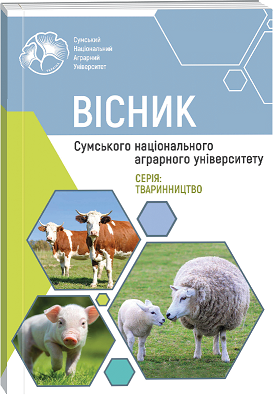HISTORICAL ASPECTS OF THE TRANSFORMATION OF THE SYSTEM OF EVALUATION OF DOGS' WORKING QUALITIES UNDER THE NATIONAL PROGRAM "VIDSICH" (PROTECTIVE DOG)
Abstract
The research analyzed archival materials of reports on competitions of applied types of dog training under the national program "Vidsich" of the All-Ukrainian public organization "Kennel Union of Ukraine" for 2009–2013. The evaluation of the working qualities under the program "Protective Dog" was carried out on a 100-point scale, according to the demonstration of 5 skills by the animal: neutralization of an enemy who shoots at the guide, repulsion of an attack by a group of enemies, protection of the guide, independent protection and defense, and the behavior of the dog during the test. Studies have shown that the best results in competitions are demonstrated by dogs of the Renschnauzer breed (83.50±5.89 points), with an average coefficient of variation indicating a slight difference in performance among dogs of this group. In addition, excellent working qualities in the performance of skills were demonstrated by American Pit Bull Terriers and South African Mastiffs, which statistically significantly received high scores on the average test score (M=79.75–79.76 points; P≥0.999). Taking into account the reliability criterion, it was proved that there is a positive relationship between the scores of the first four skills of protection and security of the guide and the total score for the implementation of the "Protective Dog" program (r=0.59–0.66; P≥0.999). Therefore, taking into account the results of the correlation between the assessment of dog skills and the overall score at the competition, we can reasonably confirm the need to change the assessment system. The need to give greater priority to the assessment of the skill of "Independet protection and defense" and, accordingly, to reduce the number of points for fulfilling the conditions of the skill "Dog behavior during tests" has been established. The final analysis proved the influence of the skill of self-defense and protection on other skills. Based on these data, a scientific justification was provided for the correctness of changing the scoring system for this test.
References
2. Bula L.V., Svysenko S.V., Pavlenko Yu.M. (2020). Vplyv pervynnykh faktoriv doboru na robochi yakosti sobak suprovodu [Influence of primary selection factors on working quality accompanying dogs]. Visnyk Sumskoho NAU. Seriia «Tvarynnytstvo», issue 4 (43), pp. 148–154. DOI: 10.32845/bsnau.lvst.2020.4.21 (in Ukrainian).
3. Chapman SG.(1990). Police Dogs in North America.Springfield: Charles C Thomas Publisher.
4. Joshua J. Mark (2018). Domestication and Contribution of Dogs in the Ancient World. URL: https://brewminate.com/domestication-and-contribution-of-dogs-in-the-ancient-world [Accessed: 09.03.2023].
5. Joshua J. Mark (2019). Dogs in the Ancient World. URL: https://www.worldhistory.org/article/184/dogs-in-the-ancientworld [Accessed: 09.03.2023].
6. Kevin W. Bliss (2023). A Brief History of K-9 Units in Law Eurororcement. URL: https://www.criminallegalnews.org/news/2023/mar/16/brief-history-k-9-units-law-enforcement [Accessed: 19.03.2023].
7. Khmelnychyi L.M., Suprun I.O., Salohub A.M. (2011). Osnovy henetyky tvaryn z biometriieiu. Navchalnyi posibnyk [Fundamentals of animal genetics with biometrics. Study guide]. Sumy: PP Vinnychenko M.D., FRP Domenko V.V.
8. Leeder Borlant (04.2022). History of guard and protection dogs. URL: https://www.protectiondogs.co.uk/history-ofguard-dogs [Accessed: 02.03.2023]).
9. Leeder Borlant (09.2022). Training family protection dogs. URL: https://www.protectiondogs.co.uk/training-familyprotection-dogs/ [Accessed: 02.03.2023].
10. Leeder Borlant (11.2022). Characteristics of protection dogs. URL: https://www.protectiondogs.co.uk/characteristicsof-protection-dogs/ [Accessed: 02.03.2023].
11. Logan Nye (2017). A Brief History of Dogs in Warfare. URL: https://www.military.com/undertheradar/2017/03/briefhistory-dogs-warfare [Accessed: 09.03.2023].
12. Steeve Scott (2022). The great history of K9 police dogs. URL: https://wamiz.co.uk/dog/advice/24652/the-great-history-of-k9-police-dogs [Accessed: 06.03.2023].
13. Trueman C. N. (2015). Dogs in World War One. The History Learning Site. URL: https://www.historylearningsite.co.uk/world-war-one/the-western-front-in-world-war-one/animals-in-world-war-one/dogs-in-world-war-one [Accessed: 05.03.2023].
14. Vysotskyi V. (2010). Polozhennia KSU «Pro poriadok provedennia vyprobuvan ta zmahan za prohramoiu Sobaka suprovodu (SS)» [Regulation of the KUU "On the Procedure for Conducting Trials and Competitions under the Assistance Dog (AD) Programme"]. URL: https://varlay.com.ua/index.php?idname=8var1 [Accessed 05.03.2023]. (in Ukrainian).
15. Vysotskyi V. (2013). Metodychni vkazivky po pidhotovtsi sobak po kompleksu okhoronno-zakhysnykh prohram «Vidsich» [Methodological guidelines for training dogs under the "Vidsich" security and protection programme]. URL: https://varlay.com.ua/index.php?idname=22var83 [Accessed 05.03.2023]. (in Ukrainian).
16. Vysotskyi V. (2014). Polozhennia Vseukrainskoi hromadskoi orhanizatsii “Kinolohichna spilka Ukrainy” "Pro poriadok provedennia vyprobuvan ta zmahan za prohramoiu "Sobaka suprovodu"" [Regulation of the All-Ukrainian Public Organisation "Kennel Union of Ukraine" "On the Procedure for Conducting Tests and Competitions under the "Assistance Dog" Programme"]. URL: https://varlay.com.ua/index.php?idname=22var83 [Accessed 05.03.2023]. (in Ukrainian).

 ISSN
ISSN  ISSN
ISSN 



